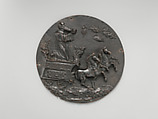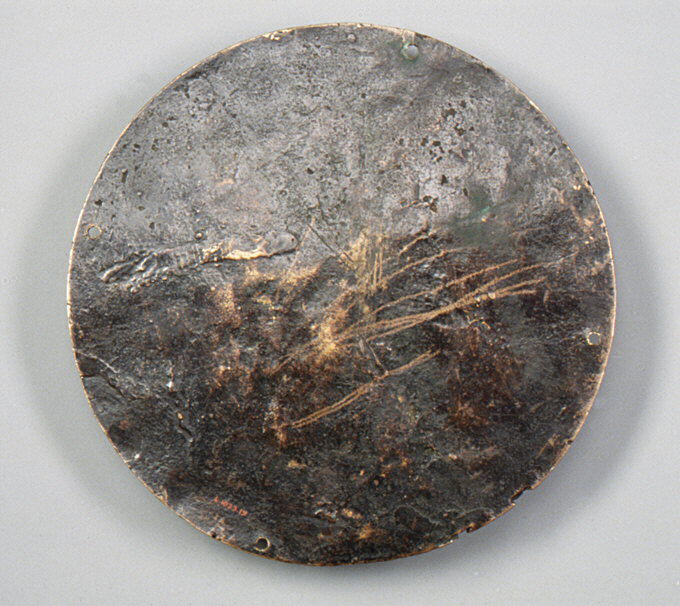Elijah in the Fiery Chariot
Master of the Barbarigo Reliefs
Chariot aflame and pulled by two horses, the Hebrew prophet Elijah kneels and clasps his hands in prayer during his miraculous ascension into heaven. This elegant relief presents the climactic moment from the Book of Kings as the elderly Elijah and his disciple Elisha are parted: “A chariot of fire and horses of fire separated the two of them, and Elijah went up to heaven in a whirlwind” (2 Kings 2:11).
Artists—like Giotto at the Arena Chapel—typically included the figure of Elisha, earthbound and receiving the mantle of Elijah, the exchange symbolizing the continuity of the Church. Here, within the format of the roundel, the artist excised Elisha, focusing the drama on Elijah’s ascent. The relief’s designer cannily exploited any potential limitations within the roundel’s format to conceive a dynamic, balanced, and clarified composition. The protagonist’s severe features and placement in the upper left are counterpoised by the energetic and playful animals at lower right, an effective diagonal echoed by the rhythmic visual parallels between Elijah’s beard and the horses’ faces.
A variety of surface textures are employed, including a smooth modeling of the equine bodies, a sketchy quality to the clouds, pulsating curlicues of flames, and ornate patterning of the chariot’s decoration. The background punchwork creates a subtle matte effect that provides contrast for the scene’s disparate elements. Three-dimensionality and a sense of depth are evoked by deft foreshortening of the chariot and the undercutting of the horses’ heads to present them in the round. The sense of a narrative scene unfolding, frozen mid-action, is suggested by the different placements of the chariot’s wheel spokes, its off-kilter tilt, and the escaping wisp of flame in the scene’s upper center.
The relief is one of three extant versions, together with examples in the Mimara Museum, Zagreb, and the Ashmolean (fig. 55a). Jeremy Warren has recently catalogued the Ashmolean exemplar and discussed all three versions.[1] Both the Oxford and New York bronzes came from the collection of French journalist and photographer Eugène Piot, who acquired the present work in Italy in 1856.[2] It is listed on an inventory that same year as “Elie sur un char de feu” and valued at 200 francs.[3] The relief eventually entered the collection of J. Pierpont Morgan and was posthumously gifted to The Met in 1917. An early twentieth-century mention of a similar relief in a Polish private collection is likely the bronze in Zagreb.[4]
Though all three reliefs were probably products of the same Venetian workshop at the beginning of the cinquecento, there are variations among them. Chief among these, heretofore unknown, are the remains of oil gilding on the surface of The Met’s bronze, faintly visible upon close inspection and confirmed by XRF analysis.[5] Now largely gone, the gilding would have covered many of the textural or decorative elements, including the foreground, the chariot embellishments, the horses’ manes, and, of course, the chariot’s fire. The New York cast is the most polished in modeling and compositional details. The presence of gilding confirms its production as a luxury object, and the finest of the three casts. In addition to lacking traces of gilding, the Oxford version omits the background punchwork, and a casting flaw likely necessitated the separately cast large cloud at right. Warren suggests that the Oxford bronze was part of a larger altar arrangement, while the New York relief has four holes, though where it was originally affixed is unknown.
All three feature unique ornamentation on Elijah’s chariot. In contrast to the floral patterning of the New York chariot and its wheels (what Warren calls “mannered”), the Ashmolean chariot is decorated with two small relief scenes set within classicizing pilasters. The Zagreb relief, the crudest of the three bronzes, features a simplified chariot bearing only an inscription: SIC PETI/TVR COE/LVM. While Warren posited that the Oxford cast was earliest, and that the New York cast “lacks the charming naivety which distinguishes [Oxford’s],” the high quality of the present version suggests instead that it was the exemplar and that the other two are later interpretations by lesser hands.
To whom did these hands belong? Since the nineteenth century, the reliefs have been typically associated with the so-called Master of the Barbarigo Reliefs, the unknown artist or artists responsible for the now-destroyed monument to the Venetian doges Marco and Agostino Barbarigo. The three surviving bronze reliefs, depicting the Assumption, the Coronation of the Virgin, and three apostles, are today in the Ca’ d’Oro, Venice.[6] Charles F. Bell was the first to connect these reliefs to the Oxford Elijah, and Joseph Breck published the New York cast as by Alessandro Leopardi, whom he related to the unknown Master.7 Leopardi, along with the Lombardi, is within the ambit of the shop that produced the Barbarigo reliefs, which, like our Elijah, have punched backgrounds. They differ stylistically, however. Our relief was likely produced by a thus far anonymous sculptor working within the same circle. An alternative suggestion that ties the Oxford Elijah to a Saint Jerome in the Ashmolean now connected to Severo da Ravenna, and thus to a Paduan origin, is intriguing but must remain speculative.[8]
Though Warren suggests the Oxford cast may have formed part of a now-lost altarpiece, perhaps depicting the Transfiguration, and paired with a Moses relief, the Elijah bronzes instead may have been intended as Carmelite commissions. While not a saint, Elijah was considered a protofounder of the Carmelites, the mendicant order established in the thirteenth century on Mount Carmel in Israel. The Venetian Carmelite church of Santa Maria dei Carmini received a raft of new decoration throughout the sixteenth century; attention was turned to the order and by extension Elian imagery contemporaneously with the bronzes’ production.[9] Might the Elijah roundels have been intended, if not expressly for the church’s interior, then for members of the various scuole associated with the order?
-JF
Footnotes
(For key to shortened references see bibliography in Allen, Italian Renaissance and Baroque Bronzes in The Metropolitan Museum of Art. NY: The Metropolitan Museum of Art, 2022.)
1. Warren 2014, pp. 154–58, no. 42.
2. I am grateful to Hubert Goldschmidt for sharing his research on the Piot auction in a September 24, 2020, email correspondence: “According to the proces-verbal of the 1864 Piot auction, the buyer was Alfred Armand and the hammer price was 250 francs; however, this medallion is not included in the list of Armand’s acquisitions at this sale found in his copy of the catalogue. Thus Armand bid on it on behalf of another collector . . . according to one of Piot’s handwritten lists of acquisitions, Piot acquired it in Italy in 1856.”
3. Bibliothèque de l’Institut de France, Paris, Ms. 2228, fol. 386, “Objets d’art et curiosités,” as cited and discussed in Warren 2014, p. 154. By 1860, the work was listed again and valued at both 200 and 250 francs in different sections of the same inventory. See ibid., pp. 154, 158 n. 3. 4. Ibid., p. 158 n. 4.
5. XRF analysis identified the alloy as brass with traces of lead, antimony, tin, and silver, and confirmed the presence of gold-leaf gilding in two areas tested, on the clouds at bottom right and on the tail of the horse at left. F. Carò/AR, April 4, 2019. I am also grateful to Linda Borsch for studying the relief with me.
6. See Augusti 2008.
7. For Bell’s discussion, see Warren 2014, p. 158, who presents annotations from an 1889 manuscript catalogue. For the New York bronze, see Breck 1913b.
8. See Warren 2014, p. 158, for a discussion of this connection, which was first proposed by C. D. E. Fortnum in 1876.
9. See Hammond 2012.
Due to rights restrictions, this image cannot be enlarged, viewed at full screen, or downloaded.
This artwork is meant to be viewed from right to left. Scroll left to view more.



